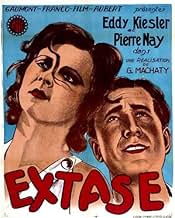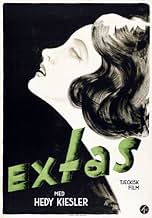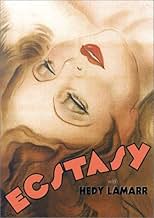IMDb-BEWERTUNG
6,6/10
2974
IHRE BEWERTUNG
Eva hat gerade einen älteren Herrn geheiratet. Sie verlässt ihn, und eines Tages lernt sie einen jungen Mann kennen und sie verlieben sich. Das Schicksal bringt den Ehemann mit dem jungen Li... Alles lesenEva hat gerade einen älteren Herrn geheiratet. Sie verlässt ihn, und eines Tages lernt sie einen jungen Mann kennen und sie verlieben sich. Das Schicksal bringt den Ehemann mit dem jungen Liebhaber zusammen, der ihm Eva genommen hat.Eva hat gerade einen älteren Herrn geheiratet. Sie verlässt ihn, und eines Tages lernt sie einen jungen Mann kennen und sie verlieben sich. Das Schicksal bringt den Ehemann mit dem jungen Liebhaber zusammen, der ihm Eva genommen hat.
- Auszeichnungen
- 2 Gewinne & 1 Nominierung insgesamt
Hedy Lamarr
- Eva Hermann
- (as Hedy Kiesler)
Emil Jerman
- Eva's husband
- (Synchronisation)
Antonín Kubový
- Landarbeiter
- (as Antonin Kibový)
Bedrich Vrbský
- Eva's father
- (Synchronisation)
Jirina Stepnicková
- Eva
- (Synchronisation)
Ladislav Bohác
- Adam
- (Nicht genannt)
Comedian Harmonists
- Themselves
- (Nicht genannt)
Kani Kipçak
- Dr. Brady
- (Nicht genannt)
Karel Macha-Kuca
- Der Rechtsanwalt
- (Nicht genannt)
Jirina Steimarová
- Typist
- (Nicht genannt)
Empfohlene Bewertungen
Dripping with symbolism and filled with marvelous cinematography, Extase is so much more than the erotic drama we've all come to expect. This is almost a silent film, with what dialogue there is in German, and highly simplified German at that. Perhaps the filmmakers intended the film to reach the widest possible European audience, as anyone with even a little high school level Deutsch can easily dispense with the subtitles. The story is of little importance anyway, with the film succeeding on a cinematic level, not a narrative one. Symbols of fecundity and the power of nature overwhelm the human characters--there are even scenes where flowers obscure the face of supposed star Hedy Lamarr--and there are moments here that will remind viewers of the works of Dreyer, Vertov, and Riefenstahl. If the film has any message to convey, I think it's a political one: bourgeois man is timid and impotent; working class man is a happy, productive creature; and woman is the creator, destined to be unfulfilled until she has borne a child. This blend of Soviet socialist realism and National Socialist dogma doesn't overwhelm the film by any means--it's a beauty to watch from beginning to end--but it does place it in a very distinct artistic era. And, oh yeah, Hedy does get her kit off.
This was a very daring film for it's day. It could even be described as soft-core porn for the silent era. It was a talkie, but dialog was extremely limited, and in German. One did not need it anyway.
The young (19) Hedy Lamarr gets trapped in a loveless marriage to an obsessive (stereotype?) German and after a short time in a marriage that was apparently never consummated, returns home to her father.
In a famous and funny scene, she decides to go skinny dipping one morning when her horse is distracted by another. She is then forced to run across a field chasing after it, as she left her clothing on the horse. An engineer retrieves her horse and returns her clothing - after getting an eyeful.
They sit for a while and, in a zen moment, he presents her with a flower with a bee sitting on top. This is where she thinks back to her honeymoon and the actions of her husband and an insect. She knows this man is different.
She returns home and eventually seeks out our young fellow, and finds the ecstasy she was denied. You can use your imagine here, but his head disappears from view and we see her writhing with pleasure. Since he never got undressed, you can imagine... Certainly, an homage to women by the director Gustav Machatý, and a shock to 1933 audiences.
The only thing that mars this beautifully filmed movie is the excessive guilt, and a strange ending.
The young (19) Hedy Lamarr gets trapped in a loveless marriage to an obsessive (stereotype?) German and after a short time in a marriage that was apparently never consummated, returns home to her father.
In a famous and funny scene, she decides to go skinny dipping one morning when her horse is distracted by another. She is then forced to run across a field chasing after it, as she left her clothing on the horse. An engineer retrieves her horse and returns her clothing - after getting an eyeful.
They sit for a while and, in a zen moment, he presents her with a flower with a bee sitting on top. This is where she thinks back to her honeymoon and the actions of her husband and an insect. She knows this man is different.
She returns home and eventually seeks out our young fellow, and finds the ecstasy she was denied. You can use your imagine here, but his head disappears from view and we see her writhing with pleasure. Since he never got undressed, you can imagine... Certainly, an homage to women by the director Gustav Machatý, and a shock to 1933 audiences.
The only thing that mars this beautifully filmed movie is the excessive guilt, and a strange ending.
This early German talkie stars the gorgeous Hedy Lamarr as a bored hausfrau and is notorious for not only showing her in her birthday suit but also in the throes of passion. The film was banned in the US! For that reason alone, one should watch it. Lamarr is truly beautiful and offers a strong performance as the woman who falls for the security of an older man (and marries him) only to become restless and subsequently enthralled with a younger, more exciting lover.
This is romanticism in the original 18th and 19th century sense of exalting human emotion and imagination, depicting the nature of sex and human relations in terms of powerful, elemental forces mirrored and symbolized in nature. It's prototypical also of European art cinema, which I've always had a weakness for. A romance, yes, but not in the sense of some smarmy "relationship" flick. All that aside, it's just strikingly beautiful, and a real treat for people who relish earlier styles of film-making. On reading some brief blurbs about the new DVD edition before getting it, I kind of got the impression that it was some cheap "shocker" in the manner of "Sex Madness" or "Reefer Madness," which couldn't be further from the truth.
As has been remarked, it's practically a silent film with a continuous musical score. Released very early in the 1930s, I have to wonder if it wasn't originally conceived and largely shot as a silent, and retrofitted for sound. Spoken lines are never more than a brief sentence or two, and most often just one or two words. This is at a time when American films were thick with dialog, taking full advantage of the new sound technology. I think much of the communicative power of cinematography was shoved aside or forgotten with the advent of sound. Had this picture been done in the United States at that time, quite apart from the demands of the sensors, a continuous patter of verbal exposition and just plain yammering would have been insisted-on by those financing it. Thankfully, it wasn't, and we still have this almost-forgotten gem to show for it.
The direction and cinematography isn't really revolutionary for its time, as it uses techniques, camera tricks, editing and points-of-view that had already been invented by earlier pioneers of silent film, but their presence still makes it stand strikingly apart from the vast majority of mainstream films of the era. There is visual sexual symbolism obvious enough to raise a giggle or two from some modern viewers (Eva pensively toys with her ring while lying on the bed on her wedding night, one drooping flower drips into another receptively open flower after a violent rainstorm). It's hardly out of place, as sex is at the very center of the film.
The musical score is extremely specific to the action, and is highly lyrical. It may strike some modern viewers as a bit too cloyingly sweet, but I find it appropriate to the style and powerfully effective for getting you into the spirit of the piece. It helps evoke the wide range of mood in the film, which at the very start almost looks like a whimsical romantic comedy. The mood darkens considerably as it moves on.
A story is told powerfully and with great visual artistry, without any superfluous exposition or jabber. For me, it's the essence of cinema. It was a big surprise for me, and I'm grateful for the opportunity to finally see it.
As has been remarked, it's practically a silent film with a continuous musical score. Released very early in the 1930s, I have to wonder if it wasn't originally conceived and largely shot as a silent, and retrofitted for sound. Spoken lines are never more than a brief sentence or two, and most often just one or two words. This is at a time when American films were thick with dialog, taking full advantage of the new sound technology. I think much of the communicative power of cinematography was shoved aside or forgotten with the advent of sound. Had this picture been done in the United States at that time, quite apart from the demands of the sensors, a continuous patter of verbal exposition and just plain yammering would have been insisted-on by those financing it. Thankfully, it wasn't, and we still have this almost-forgotten gem to show for it.
The direction and cinematography isn't really revolutionary for its time, as it uses techniques, camera tricks, editing and points-of-view that had already been invented by earlier pioneers of silent film, but their presence still makes it stand strikingly apart from the vast majority of mainstream films of the era. There is visual sexual symbolism obvious enough to raise a giggle or two from some modern viewers (Eva pensively toys with her ring while lying on the bed on her wedding night, one drooping flower drips into another receptively open flower after a violent rainstorm). It's hardly out of place, as sex is at the very center of the film.
The musical score is extremely specific to the action, and is highly lyrical. It may strike some modern viewers as a bit too cloyingly sweet, but I find it appropriate to the style and powerfully effective for getting you into the spirit of the piece. It helps evoke the wide range of mood in the film, which at the very start almost looks like a whimsical romantic comedy. The mood darkens considerably as it moves on.
A story is told powerfully and with great visual artistry, without any superfluous exposition or jabber. For me, it's the essence of cinema. It was a big surprise for me, and I'm grateful for the opportunity to finally see it.
There's no entertainment value in this confusing montage fest. There's a love triangle melodrama wrapped inside, but it's not worth the price of admission. I suspect the film is dripping with all sorts of symbolism, but what it says is never entirely clear. We get shots of flowers, horses, pick axes, and flies, flies, flies. The artsy montages interrupt the story whenever possible and go on and on, overstaying their welcome after delivering their messages.
This practically silent Czech-made movie is notable today for its nude and erotic scenes with Hedy Lamarr, years before she became a star in Hollywood. The scenes, tastefully done, really pushed the envelope back in the early 1930s, giving this film some historical significance.
It boggles my mind to see so many rave reviews for this film. Sure, it has its claims to cinematic history, but this is not a very good film. It is way too drawn out, weighed down by heavy-handed symbolism, and ultimately unsatisfying. A footnote in a textbook, sure, but no masterpiece.
Perhaps one must possess a certain artistic mind to fully appreciate this film's "poetry". If that is the case, I guess I just don't have it.
Not worth your time except as a curiosity for the rabid cinephile.
This practically silent Czech-made movie is notable today for its nude and erotic scenes with Hedy Lamarr, years before she became a star in Hollywood. The scenes, tastefully done, really pushed the envelope back in the early 1930s, giving this film some historical significance.
It boggles my mind to see so many rave reviews for this film. Sure, it has its claims to cinematic history, but this is not a very good film. It is way too drawn out, weighed down by heavy-handed symbolism, and ultimately unsatisfying. A footnote in a textbook, sure, but no masterpiece.
Perhaps one must possess a certain artistic mind to fully appreciate this film's "poetry". If that is the case, I guess I just don't have it.
Not worth your time except as a curiosity for the rabid cinephile.
Wusstest du schon
- WissenswertesFirst surviving non-pornographic film to depict a woman having an orgasm.
- PatzerIn the beginning when Emil is in the bedroom, a closeup of the photo on the bedside table is shown to have writing on it. On the second closeup, when Emil is carefully rearranging his keys and other items, there is no writing.
- Zitate
Eva Hermann: Tell him... no. Don't tell him anything.
- Alternative VersionenTo get the film around the more conservative German censors, an alternate version of Hedy Lamarr's nude bathing scenes was shot in which she was partially obscured by strategically-placed bushes.
- VerbindungenEdited into Geschichte(n) des Kinos: Fatale beauté (1994)
Top-Auswahl
Melde dich zum Bewerten an und greife auf die Watchlist für personalisierte Empfehlungen zu.
- How long is Ecstasy?Powered by Alexa
Details
- Laufzeit
- 1 Std. 22 Min.(82 min)
- Farbe
- Sound-Mix
- Seitenverhältnis
- 1.19 : 1
Zu dieser Seite beitragen
Bearbeitung vorschlagen oder fehlenden Inhalt hinzufügen































